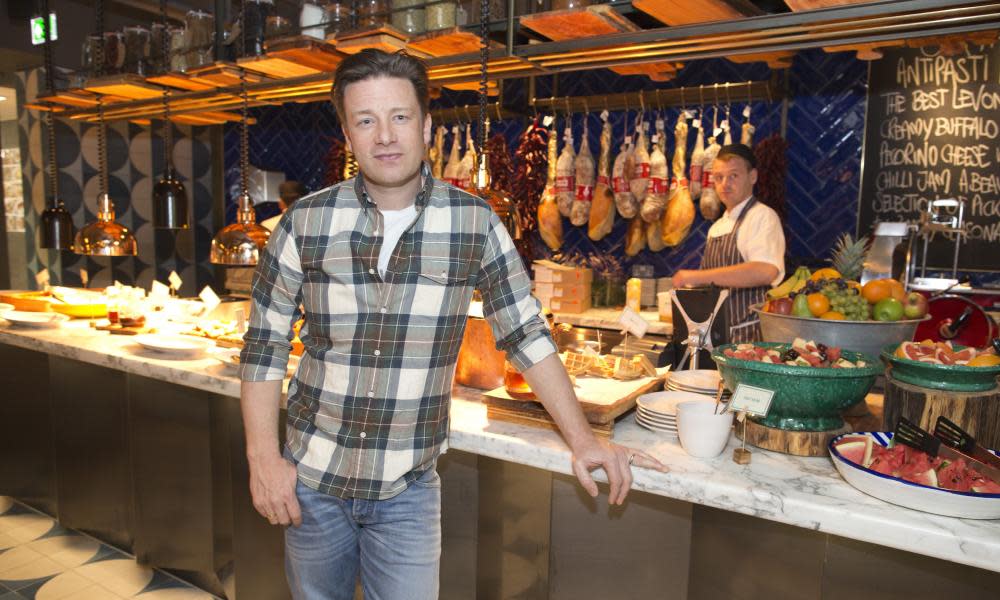Will a sugar tax work? Well, it did at Jamie Oliver's Italian restaurants

Jamie Oliver’s 10p tax on sugary drinks sold in his Italian restaurants has resulted in a significant drop in sales, a study has found.
The Jamie’s Italian chain introduced the sugary drinks tax to set an example as part of a campaign to persuade the government to take action. In June 2015, Oliver announced that every drink containing added sugar would cost 10p extra and that the money would help pay for food education and water fountains in schools.
A study of the effects of the levy, published in the Journal of Epidemiology & Community Health, has found that sales of sugar-sweetened drinks such as colas and lemonades fell by 11% in the first 12 weeks. At the end of six months, sales were 9.3% lower than they had been before the levy was introduced.
Prof Steven Cummins of the department of social and environmental health research at the London School of Hygiene and Tropical Medicine, who carried out the study, acknowledged that the clientele of Oliver’s restaurants tended to be affluent, and that the price hike on a drink costing between £2.60 and £3.25 might not make a lot of difference to them.
We can’t be sure that the fall in consumption of sugary drinks was entirely, or even mainly, caused by the extra 10p
“I don’t think the financial element of it is a massive disincentive,” he said. But he likened it to the plastic bag charge, which prompts people to think about having one.
The menu explains the purpose of the levy and, at the time of the launch, Oliver was fronting a television documentary on the potential damage of sugary drinks to children’s health, called Jamie’s Sugar Rush.
When it came to the government tax on drinks containing added sugar, which begins in April 2018 – assuming it is passed on to the consumer and not absorbed by some of the multinational companies making popular drinks – the impact would likely depend on how much educational messaging accompanied the price rise, said Cummins.
“If you want to optimise the effect at point-of-sale [in shops], perhaps signage or other elements that could be put on the shelves themselves might have an impact over and above the financial incentive,” he said.
In the 12 months leading up to the introduction of the levy, more than 2m non-alcoholic drinks were sold in the 37 Jamie’s Italian restaurants, of which 38% (773,230) were sugar sweetened.
The drop in sales at six months of 9.3% was only in the restaurants that previously had higher levels of sales of sweetened drinks. There was a general drop in sales on non-alcoholic beverages, except for fruit juices, which went up. There is no evidence as yet on whether alcohol sales also went up. Cummins said it was possible that more people were drinking tap water, which is not billed and therefore did not appear in the sales figures.
He said he thought the effect was “entirely transferable” to other less expensive chains. “There is no reason why other restaurants couldn’t do exactly the same,” he said. Those that have the highest sales of sweetened drinks would be likely to have the biggest falls.
Susan Jebb, professor of diet and population health at the University of Oxford said this was the first evidence of the effects of a price rise in a restaurant setting and could not be considered conclusive.
“Nonetheless this is a careful analysis and shows a greater than anticipated fall in sales, which is encouraging news for public health ahead of the introduction of the soft drink industry levy next year,” she said.
“Surprisingly, and unlike the experience in some other countries, there was also a decline in low- and no-sugar drinks, which is harder to explain. The gap in the paper is data on alcohol sales, since any compensatory increase (which may or may not have occurred) would be of considerable concern given the potential contribution to energy intake and health harms. Businesses will also want to understand more about the likely impact on turnover.”
Kevin McConway, emeritus professor of applied statistics at the Open University, said there was a lot more going on than just the price increase. “The menu was redesigned: it explained that the proceeds of the levy would go to the Children’s Health Fund, new drink products were introduced, and Jamie himself appeared in a television programme about sugar. So we certainly can’t be sure that the fall in consumption of sugary drinks was entirely, or even mainly, caused by the extra 10p.
“The researchers do provide some circumstantial evidence that the 10p played a role in the reduction in consumption, but they (rightly) make it clear that a study like this can’t prove what caused what. Actually, it doesn’t even establish that any of the specific changes at Jamie’s Italian restaurants had anything to do with the lower consumption – for instance, the researchers had no data from any other restaurants, and maybe consumption fell there as well.
“Jamie Oliver isn’t the only person to have been on TV pointing out the health consequences of too much sugar, and the general publicity that sugary drinks are bad for health is likely to have had some general effect on consumption,” McConway said.

 Yahoo News
Yahoo News 
